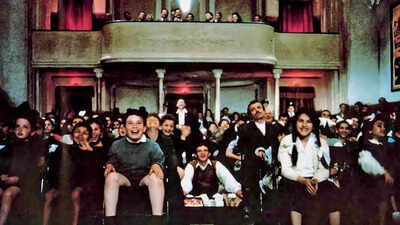ARTICLE AD BOX

A still from Cinema Paradiso
When Amitabh Bachchan recently shared a ticket from a Sholay screening, what caught attention was the seat classification printed in bold: Special Class. According to film experts, such tickets reflect a long-forgotten language of cinema-going in India.
Your seat didn’t just determine your view, it also revealed your social standing. “It wasn’t a standard classification at all cinemas. But the ticket is from Excelsior cinema in Bombay (Mumbai), where the last few rows, separated from the main cluster of seats, were called Special Class,” says film historian Shivendra Singh Dungarpur.Today, watching a film is a different experience – with recliners, gourmet snacks, and curated drinks, it feels more like a luxe night out.
But it wasn’t always this fancy. Experts say old movie tickets act like time capsules, capturing how your seat reflected both access and your place in society.

When Amitabh Bachchan recently shared a ticket from a Sholay screening, what caught attention was the seat classification printed in bold: Special Class
‘Front bench full hai toh film hit hai – yeh criteria tha hit film ka’The front bench was as crucial as the director’s name on the poster. “Front bench full hai toh film hit hai – yeh criteria tha hit film ka ,” laughs Alok Diesh, a veteran in the cinema business, who was around long before ticketing apps came along.
He says that the front bench was rowdy and loud. If those seats – often the cheapest and closest to the screen – were packed, it meant the film had made its way to the masses.Chaitanya Prasad, a moviegoer in his 60s, recalls, “Balcony seats were always something to envy. It was almost like winning a medal if you got a ticket for the latest release. So, a balcony ticket was just something we could only wish for as students. And some places, like Regal, even had box seats for VIPs.”“Cinema owner toh DM se bada hota tha !” jokes film distributor Sanjay Ghai. “DM bhi film ki ticket ke liye usi ko phone karta tha . If the show was full, the manager would actually put the phone aside to avoid requests.”

Sholay screening
The balcony, the box, and the dress circleCine experts say that back in the day, your seat at the movies didn’t just decide your view – it said something about who you were. “In the ’50s and ’60s, men and women wouldn’t sit together. They had separate seats,” says Shivendra Singh Dungarpur.
“Then came the idea that families could sit together. Later, the halls were redesigned to include balconies, dress circles, stalls. The stalls were closer to the projection and had a better angle.The dress circle was more separated and above.”Film historian Gautam Chintamani describes seating at that time as highly stratified. “Roughly 65–80% of a cinema hall consisted of regular seats. Above those, you had the balcony, dress circle, and family boxes – small private enclosures with curtains or side doors.
It used to be reserved for VIPs or people who didn’t want to be seen. So the seating reflected that hierarchy,” he says.From places of leisure to places of luxury – the evolution of cinema seatingPost-Emergency (1975), while film content shifted towards escapism, the kind of audience frequenting cinema halls also changed. A certain segment of society – families and the working-class continued going to theatres. For them, cinema was an escape.
You could smoke during interval (inside the cinema), have a cold drink and unwind. Seating reflected this shift, as theatres became places of affordable leisure for the masses.Technological upkeep of theatres declined in the late 80s. India had 70mm theatres, grand halls with large seating capacities, but over time, infrastructure deteriorated.Filmmaker Mansoor Khan once mentioned how he visited a theatre to watch Qayamat Se Qayamat Tak (1988) and found the doors didn’t shut completely, allowing light to spill onto the screen, and how 300–400 chairs creaked due to lack of oiling or maintenance.
This decline shows the type of audience that still came to theatres – mainly lower and middle classes – while the elite moved towards home entertainment.A significant shift happened with Hum Aapke Hain Koun..! (1994) . For the first time, a filmmaker gave theatre owners a checklist – unless the cinema had a particular sound system, clean restrooms (especially for women), and quality snacks, the film would not be released.
This forced theatres to upgrade their infrastructure.By late 90s, multiplexes like Priya in Delhi ushered in a new era. With aIndvanced sound, better projection, and more comfortable seating, the expectations around what a cinema experience should feel like changed. By the 2000s, theatres began offering recliners, blankets, and luxury lounges. Cinema-going became an upscale, family-friendly outing.– Film historian Gautam Chintamani
"Get the latest updates on Times of India, including reviews of the movie Coolie and War 2."



.png)
.png)
.png)
















 8 hours ago
3
8 hours ago
3









 English (US) ·
English (US) ·